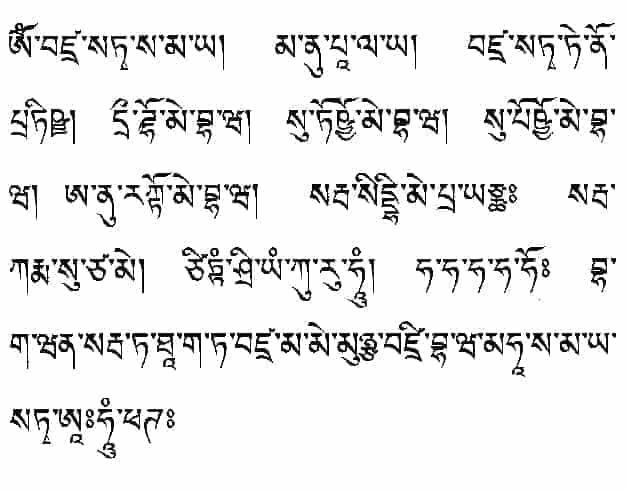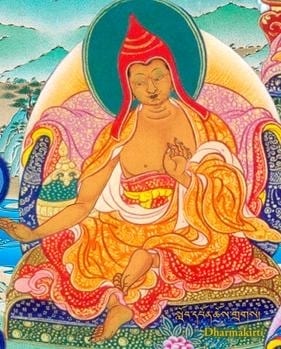In Buddhist texts, we encounter two related but slightly different terms that refer to incantations or invocations associated with powerful properties. Dhāraṇī and Mantra both may involve the holding or keeping in one’s mind particular aspects of the Dharma. These collections of sacred syllables also embody the qualities of enlightened beings. This topic is vast and complex, and scholars from many traditions argue fine points of distinction. In this introduction, we offer a brief overview of the subject and include information on the current state of the scientific study of mantra practice.
Etymology
Dhāraṇī or zung (gzungs in Tibetan) derives from the Sanskrit root √dhṛ, meaning “to hold or maintain.” Although there are variations, one belief is that dhāraṇī function as a type of mnemonic device to aid practitioners in recollecting the teaching. They also aid in focusing the mind in meditation, preventing distraction and mind-wandering from arising as obstacles.
A dhāraṇī often begins with a salutation such as om namo bhagavate, translated as “Om, Homage to the Blessed One.” Dhāraṇī feature frequently in Mahayana literature. Because they have mastery of samādhi, bodhisattvas can demonstrate magical or healing powers by uttering dhāraṇī.

Within the Tibetan tradition, scholars explain that mantra (sngags in Tibetan) combines two Sanskrit syllables: manas, meaning “mind,” and tra, meaning “to protect.” But we could also explain the syllable “tra” as “tool,” thus conveying the meaning “tool of the mind.” The practitioner focuses on the sound (either audible or mental) of the mantra as a tool to settle and calm the mind.
Mantras are not unique to the Vajrayana tradition. Simple mantras such as the Buddha’s name, or a series of his titles, or epithets, are found in all vehicles and traditions of Buddhism. However, due to the prevalence of mantra, we refer to the Vajrayana as the Mantrayana or the vehicle of mantra.
Recitation
When we recite mantras aloud, it is usually done in a low, smooth tone, neither too slow nor too fast. Some teachers instruct us to keep the voice low as if speaking to our shirt collar. The late Dilgo Khyentse Rinpoche explained, as an example, that when we recite the Guru Rinpoche mantra:
We should recite this mantra with our entire being, free from hypocrisy, distraction, or any kind of mechanical repetitiveness. In fact, our recitation of this mantra should be uninterrupted, like the constant flow of a river, and should become one with our breath.[1]
Most importantly, we keep our focus on the mantra and do not allow ordinary thoughts to distract us. As Shechen Gyaltsab Gyurme Pema Namgyal noted in his instructions on practice, Padmasambhava taught:
Recite with undistracted concentration.
Should you become distracted elsewhere,
Even reciting for an eon will bring no result.[2]
Traditional Explanations of Dhāraṇī
Dhāraṇī and mantra are believed to protect believers from a wide variety of afflictions, both internal and external. This is particularly true in early Mahayana texts. In some scriptures, such as The Lotus Sūtra (Saddharmapuṇḍarīka), we find the two terms combined as one: dhāraṇīmantra. Due to the power of enlightened speech, certain formulaic sounds became important for apotropaic practices averting obstacles. By reciting a particular dhāraṇī, the faithful practitioner would be protected and/or achieve mundane or supermundane goals. Such protective recitations are also found in the texts of the Pali canon and have been found in some of the earliest examples of Buddhist written material.
Dhāraṇī as Condensed Summary
Some argue that dhāraṇī aided the practitioner in grasping or retaining knowledge of the Dharma. This role of knowledge retention appears frequently in Prajñāpāramitā texts. For example, translators Zhi Qian and Kumārajīva translated the title of the popular Heart Sūtra as the Heart (or Essence) Dhāraṇī. The entire text summarizes the essence of the Prajñāpāramitā in one page. And within this terse dhāraṇī, we find the well-known mantra: Gate gate pāragate pārasaṃgate bodhi svāhā.

His Holiness the Dalai Lama has rendered this phrase as: “It is thus: Proceed, proceed, proceed beyond, thoroughly proceed beyond, be founded in enlightenment.”
In this case, this mantra is an even more concise distillation of this core Mahayana teaching. His Holiness follows the explanation given by Atiśa Dīpaṃkara Śrījñāna (982–1054) and Vajrapāṇi (b. 1019) in the Prajñāpāramitāhṛdārthapradīpa. These masters taught that the mantra encapsulated the entire meaning of the path, a truth that devotees of highest capacity could ascertain. Vajrapāṇi writes, “By merely understanding the meaning of this mantra, the mind is freed.”[3]
Mantra as Path
The Dalai Lama explained the meaning of this mantra as path by breaking down each of its component words or phrases. “Gate gate” (“proceed, proceed”) indicates the paths of accumulation and preparation. It also signifies the first experience of emptiness. The next word, “paragate” (“proceed beyond”), indicates the path of seeing, which is the first insight into emptiness and achievement of the first bodhisattva ground or bhumi. “Parasamgate” (“thoroughly proceed beyond”) indicates the path of meditation and the achievement of the subsequent bodhisattva grounds. “Bodhi svaha” (“be founded in enlightenment”) indicates laying the foundation for complete enlightenment.
Patience on the Path
In The King of Samādhis Sūtra, the Buddha explains to the Bodhisattva Youthful Moon (Candraprabha) that bodhisattva mahasattvas on the path should develop three types of patience. One of the qualities of the first type of patience is described as follows:
The retentions (dhāraṇī) become apparent to them
And they have no doubts concerning their appearance.
What they speak is in accord with the truth.
These are distinctive qualities of the first patience.
In the sūtra, the Buddha teaches four types of retention of content:
- Retention of all that is taught about the infinite composite phenomena
- Retention of what is said in infinite sounds
- Retention of everything that is taught about the infinite kleśas
- Retention of everything that is taught about the infinite benefits of the qualities of purification
Traditional Explanations of Mantra

How did traditional scholars define mantra? The Indian philosopher Dharmakīrti (active in the 6th century) wrote in his masterpiece the Pramāṇavārttika:
What we call a mantra is nothing other than an utterance [that has been pronounced] by [persons] who are endowed with a [special] power they owe to their truthfulness and austerity, [an utterance that proves] able to realize the desired purpose.
The Tibetan master Jamgön Mipham (1846–1912), emphasized that faith is required for the full efficacy of mantra. He wrote in his Guide to Guhyagarbha Tantra, Luminous Essence:
Mantras are like nonconceptual wish-fulfilling jewels. Infusing one’s being with the blessings of mantra, like the form of a moon reflected on a body of water, necessitates the presence of faith and other conditions that set the stage for the spiritual attainments of mantra. Just as the moon’s reflection cannot appear without water, mantras cannot function without the presence of faith and other such factors in one’s being.
Common Composition of Mantras
Certain syllables appear frequently in mantras; although they are formulaic, we can recognize a number of patterns. Frequently, a mantra begins with the sound “oṃ.”

In Jigmé Tenpé Nyima’s (rdo grub chen ‘jigs med bstan pa’i nyi ma) Commentary on the Guru Rinpoche mantra, he explained:
Generally, “oṃ” is placed at the beginning of a mantra. Oṃ is the mantra of consecration: it imparts glory, makes good fortune abound, and much more beside. In short, it is explained in The Tip of The Vajra[4] and elsewhere that “oṃ” embodies auspiciousness.

Modern Science and Mantra Study
In recent decades, scientists and psychologists have turned their attention to many aspects of mindfulness practice and meditation. Scientific interest is primarily driven by the interest in non-pharmaceutical treatment of stress and anxiety, and focuses attention on mundane benefits of mantra recitation (along with mindfulness and visualization practices).
As early as the 1970’s, Dr. Herbert Benson, president and founder of the Mind/Body Medical Institute at Harvard Medical School, observed the effect of mantra repetition in participants with little prior training in meditation. Findings included: lowered blood pressure, reduced oxygen consumption, and greater self-esteem. Ten minutes per day of mantra repetition, either aloud or mentally, led to measurable results and created what he dubbed the “relaxation response.”
With the advent of fMRI machines and other tools for accurate measurement, more studies have emerged. In 2015, a study published in Brain and Behavior[5] indicated that repetitive speech recitation resulted in measurably lower levels of cognitive activity and an increased sense of relaxation in participants. The authors suggested, “a neuronal mechanism may account for the uniquely calming effect of Mantra meditative practice, explaining its wide use across cultural and historical boundaries.”
Although the study of mantra has begun, it is still very young, and unfortunately most of the scientific studies to date have been poorly designed. However, a recent study that analyzed over 30 studies conducted to date concluded:
There is some evidence that mantra meditation can improve mental health related outcomes in the general, non-clinical population, however this evidence is based on individual studies of poor quality. As such, the efficacy of mantra meditation as a mechanism that provides relief from stress and a basis for more dynamic and effective activity should not be overstated at this time. Despite the poor quality of studies reviewed, positive trends are evident which suggest that such programmes may have exciting educational, occupational, and psychotherapeutic potential, offering the general population an individual approach that avoids the side effects of medications, the stigma of treatment as well as barriers related to issues of cost and accessibility. Larger trials of superior quality are required to draw more definite conclusions.[6]
Science Examining Mantra and Memory
In addition to interest in mantra repetition as a stress-reduction technique, some scientists are noticing the close connection between mantra and memory, which reminds us of the etymology of the word.
Dr. James Hartzell drew on his own experience in memorizing ancient Sanskrit texts. He launched a study on the cognitive effects of extensive memorization in the cognitive neuroscience doctoral program at the University of Trento (Italy). Although not uniquely focused on mantra, his MRI analysis of the brains of Indian pandits reciting ancient texts from memory showed substantial differences in the right hippocampus structure, the part of the brain associated with both short- and long-term memory. The results were distinctive enough to cause more interest in the so-called “Sanskrit effect.”
[1] The Wish-Fulfilling Jewel: The Practice of Guru Yoga According to the Longchen Nyingthig Tradition, Shambala, 1999.
[2] A Practice of Padmasambhava: Essential Instructions On The Path To Awakening, Shambala
[3] The Heart Sutra Explained: Indian and Tibetan Commentaries, Donald S. Lopez, p. 112.
[4] Vajraśekharamahāguhyayogatantra, gsang ba rnal ‘byor chen po’i rgyud rdo rje rtse mo)
[5] Berkovich-Ohana A, Wilf M, Kahana R, Arieli A, Malach R. Repetitive speech elicits widespread deactivation in the human cortex: the “Mantra” effect?. Brain Behav. 2015;5(7):e00346. doi:10.1002/brb3.346
[6] ‘Mantra meditation for mental health in the general population: A systematic review’ Julie Lynch,Lucia Prihodova,Pádraic J. Dunne,Áine Carroll,Cathal Walsh,Geraldine McMahon,Barry White in European Journal of Integrative Medicine, October 2018.










Responses